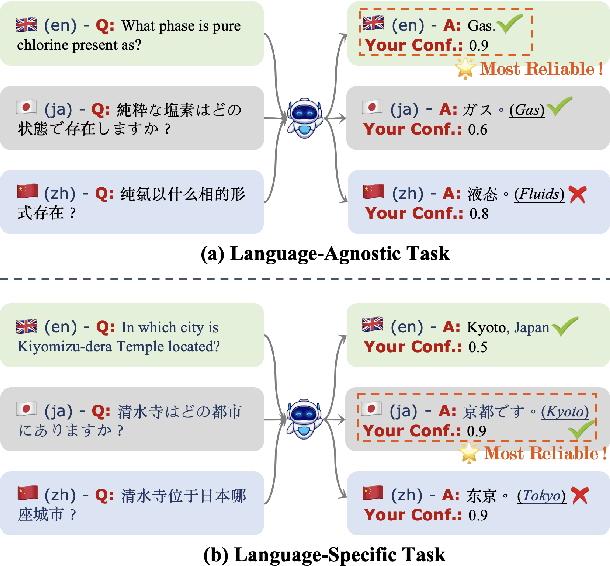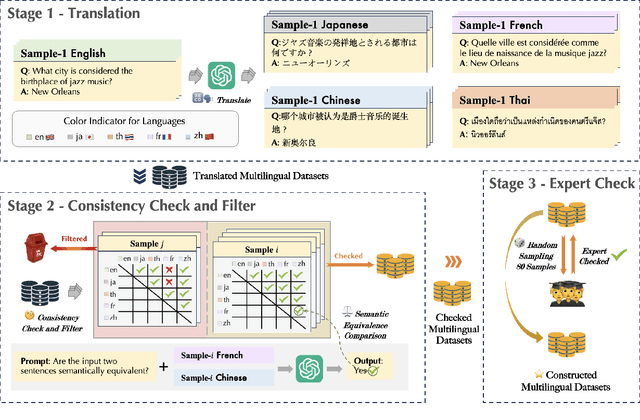Hongru Wang
Harnessing the Reasoning Economy: A Survey of Efficient Reasoning for Large Language Models
Mar 31, 2025Abstract:Recent advancements in Large Language Models (LLMs) have significantly enhanced their ability to perform complex reasoning tasks, transitioning from fast and intuitive thinking (System 1) to slow and deep reasoning (System 2). While System 2 reasoning improves task accuracy, it often incurs substantial computational costs due to its slow thinking nature and inefficient or unnecessary reasoning behaviors. In contrast, System 1 reasoning is computationally efficient but leads to suboptimal performance. Consequently, it is critical to balance the trade-off between performance (benefits) and computational costs (budgets), giving rise to the concept of reasoning economy. In this survey, we provide a comprehensive analysis of reasoning economy in both the post-training and test-time inference stages of LLMs, encompassing i) the cause of reasoning inefficiency, ii) behavior analysis of different reasoning patterns, and iii) potential solutions to achieve reasoning economy. By offering actionable insights and highlighting open challenges, we aim to shed light on strategies for improving the reasoning economy of LLMs, thereby serving as a valuable resource for advancing research in this evolving area. We also provide a public repository to continually track developments in this fast-evolving field.
DAST: Difficulty-Aware Self-Training on Large Language Models
Mar 12, 2025Abstract:Present Large Language Models (LLM) self-training methods always under-sample on challenging queries, leading to inadequate learning on difficult problems which limits LLMs' ability. Therefore, this work proposes a difficulty-aware self-training (DAST) framework that focuses on improving both the quantity and quality of self-generated responses on challenging queries during self-training. DAST is specified in three components: 1) sampling-based difficulty level estimation, 2) difficulty-aware data augmentation, and 3) the self-training algorithm using SFT and DPO respectively. Experiments on mathematical tasks demonstrate the effectiveness and generalization of DAST, highlighting the critical role of difficulty-aware strategies in advancing LLM self-training.
SMART: Self-Aware Agent for Tool Overuse Mitigation
Feb 17, 2025



Abstract:Current Large Language Model (LLM) agents demonstrate strong reasoning and tool use capabilities, but often lack self-awareness, failing to balance these approaches effectively. This imbalance leads to Tool Overuse, where models unnecessarily rely on external tools for tasks solvable with parametric knowledge, increasing computational overhead. Inspired by human metacognition, we introduce SMART (Strategic Model-Aware Reasoning with Tools), a paradigm that enhances an agent's self-awareness to optimize task handling and reduce tool overuse. To support this paradigm, we introduce SMART-ER, a dataset spanning three domains, where reasoning alternates between parametric knowledge and tool-dependent steps, with each step enriched by rationales explaining when tools are necessary. Through supervised training, we develop SMARTAgent, a family of models that dynamically balance parametric knowledge and tool use. Evaluations show that SMARTAgent reduces tool use by 24% while improving performance by over 37%, enabling 7B-scale models to match its 70B counterpart and GPT-4o. Additionally, SMARTAgent generalizes to out-of-distribution test data like GSM8K and MINTQA, maintaining accuracy with just one-fifth the tool calls. These highlight the potential of strategic tool use to enhance reasoning, mitigate overuse, and bridge the gap between model size and performance, advancing intelligent and resource-efficient agent designs.
NILE: Internal Consistency Alignment in Large Language Models
Dec 21, 2024Abstract:As a crucial step to enhance LLMs alignment with human intentions, Instruction Fine-Tuning (IFT) has a high demand on dataset quality. However, existing IFT datasets often contain knowledge that is inconsistent with LLMs' internal knowledge learned from the pre-training phase, which can greatly affect the efficacy of IFT. To address this issue, we introduce NILE (iNternal consIstency aLignmEnt) framework, aimed at optimizing IFT datasets to unlock LLMs' capability further. NILE operates by eliciting target pre-trained LLM's internal knowledge corresponding to instruction data. The internal knowledge is leveraged to revise the answer in IFT datasets. Additionally, we propose a novel Internal Consistency Filtering (ICF) method to filter training samples, ensuring its high consistency with LLM's internal knowledge. Our experiments demonstrate that NILE-aligned IFT datasets sharply boost LLM performance across multiple LLM ability evaluation datasets, achieving up to 66.6% gain on Arena-Hard and 68.5% on Alpaca-Eval V2. Further analysis confirms that each component of the NILE}framework contributes to these substantial performance improvements, and provides compelling evidence that dataset consistency with pre-trained internal knowledge is pivotal for maximizing LLM potential.
UAlign: Leveraging Uncertainty Estimations for Factuality Alignment on Large Language Models
Dec 16, 2024Abstract:Despite demonstrating impressive capabilities, Large Language Models (LLMs) still often struggle to accurately express the factual knowledge they possess, especially in cases where the LLMs' knowledge boundaries are ambiguous. To improve LLMs' factual expressions, we propose the UAlign framework, which leverages Uncertainty estimations to represent knowledge boundaries, and then explicitly incorporates these representations as input features into prompts for LLMs to Align with factual knowledge. First, we prepare the dataset on knowledge question-answering (QA) samples by calculating two uncertainty estimations, including confidence score and semantic entropy, to represent the knowledge boundaries for LLMs. Subsequently, using the prepared dataset, we train a reward model that incorporates uncertainty estimations and then employ the Proximal Policy Optimization (PPO) algorithm for factuality alignment on LLMs. Experimental results indicate that, by integrating uncertainty representations in LLM alignment, the proposed UAlign can significantly enhance the LLMs' capacities to confidently answer known questions and refuse unknown questions on both in-domain and out-of-domain tasks, showing reliability improvements and good generalizability over various prompt- and training-based baselines.
Compound-QA: A Benchmark for Evaluating LLMs on Compound Questions
Nov 15, 2024



Abstract:Large language models (LLMs) demonstrate remarkable performance across various tasks, prompting researchers to develop diverse evaluation benchmarks. However, existing benchmarks typically measure the ability of LLMs to respond to individual questions, neglecting the complex interactions in real-world applications. In this paper, we introduce Compound Question Synthesis (CQ-Syn) to create the Compound-QA benchmark, focusing on compound questions with multiple sub-questions. This benchmark is derived from existing QA datasets, annotated with proprietary LLMs and verified by humans for accuracy. It encompasses five categories: Factual-Statement, Cause-and-Effect, Hypothetical-Analysis, Comparison-and-Selection, and Evaluation-and-Suggestion. It evaluates the LLM capability in terms of three dimensions including understanding, reasoning, and knowledge. Our assessment of eight open-source LLMs using Compound-QA reveals distinct patterns in their responses to compound questions, which are significantly poorer than those to non-compound questions. Additionally, we investigate various methods to enhance LLMs performance on compound questions. The results indicate that these approaches significantly improve the models' comprehension and reasoning abilities on compound questions.
Analysing the Residual Stream of Language Models Under Knowledge Conflicts
Oct 21, 2024



Abstract:Large language models (LLMs) can store a significant amount of factual knowledge in their parameters. However, their parametric knowledge may conflict with the information provided in the context. Such conflicts can lead to undesirable model behaviour, such as reliance on outdated or incorrect information. In this work, we investigate whether LLMs can identify knowledge conflicts and whether it is possible to know which source of knowledge the model will rely on by analysing the residual stream of the LLM. Through probing tasks, we find that LLMs can internally register the signal of knowledge conflict in the residual stream, which can be accurately detected by probing the intermediate model activations. This allows us to detect conflicts within the residual stream before generating the answers without modifying the input or model parameters. Moreover, we find that the residual stream shows significantly different patterns when the model relies on contextual knowledge versus parametric knowledge to resolve conflicts. This pattern can be employed to estimate the behaviour of LLMs when conflict happens and prevent unexpected answers before producing the answers. Our analysis offers insights into how LLMs internally manage knowledge conflicts and provides a foundation for developing methods to control the knowledge selection processes.
Steering Knowledge Selection Behaviours in LLMs via SAE-Based Representation Engineering
Oct 21, 2024



Abstract:Large language models (LLMs) can store a significant amount of factual knowledge in their parameters. However, their parametric knowledge may conflict with the information provided in the context -- this phenomenon, known as \emph{context-memory knowledge conflicts}, can lead to undesirable model behaviour, such as reliance on outdated or incorrect information. Analysing the internal activations of LLMs, we find that they can internally register the signals of knowledge conflict at mid-layers. Such signals allow us to detect whether a knowledge conflict occurs and use \emph{inference-time} intervention strategies to resolve it. In this work, we propose \textsc{SpARE}, a \emph{training-free} representation engineering method that uses pre-trained sparse auto-encoders (SAEs) to control the knowledge selection behaviour of LLMs. \textsc{SpARE} identifies the functional features that control the knowledge selection behaviours and applies them to edit the internal activations of LLMs at inference time. Our experimental results show that \textsc{SpARE} can effectively control the usage of either knowledge source to resolve knowledge conflict in open-domain question-answering tasks, surpassing existing representation engineering methods ($+10\%$) as well as contrastive decoding methods ($+15\%$).
MlingConf: A Comprehensive Study of Multilingual Confidence Estimation on Large Language Models
Oct 16, 2024



Abstract:The tendency of Large Language Models (LLMs) to generate hallucinations raises concerns regarding their reliability. Therefore, confidence estimations indicating the extent of trustworthiness of the generations become essential. However, current LLM confidence estimations in languages other than English remain underexplored. This paper addresses this gap by introducing a comprehensive investigation of Multilingual Confidence estimation (MlingConf) on LLMs, focusing on both language-agnostic (LA) and language-specific (LS) tasks to explore the performance and language dominance effects of multilingual confidence estimations on different tasks. The benchmark comprises four meticulously checked and human-evaluate high-quality multilingual datasets for LA tasks and one for the LS task tailored to specific social, cultural, and geographical contexts of a language. Our experiments reveal that on LA tasks English exhibits notable linguistic dominance in confidence estimations than other languages, while on LS tasks, using question-related language to prompt LLMs demonstrates better linguistic dominance in multilingual confidence estimations. The phenomena inspire a simple yet effective native-tone prompting strategy by employing language-specific prompts for LS tasks, effectively improving LLMs' reliability and accuracy on LS tasks.
Less is More: Making Smaller Language Models Competent Subgraph Retrievers for Multi-hop KGQA
Oct 08, 2024Abstract:Retrieval-Augmented Generation (RAG) is widely used to inject external non-parametric knowledge into large language models (LLMs). Recent works suggest that Knowledge Graphs (KGs) contain valuable external knowledge for LLMs. Retrieving information from KGs differs from extracting it from document sets. Most existing approaches seek to directly retrieve relevant subgraphs, thereby eliminating the need for extensive SPARQL annotations, traditionally required by semantic parsing methods. In this paper, we model the subgraph retrieval task as a conditional generation task handled by small language models. Specifically, we define a subgraph identifier as a sequence of relations, each represented as a special token stored in the language models. Our base generative subgraph retrieval model, consisting of only 220M parameters, achieves competitive retrieval performance compared to state-of-the-art models relying on 7B parameters, demonstrating that small language models are capable of performing the subgraph retrieval task. Furthermore, our largest 3B model, when plugged with an LLM reader, sets new SOTA end-to-end performance on both the WebQSP and CWQ benchmarks. Our model and data will be made available online: https://github.com/hwy9855/GSR.
 Add to Chrome
Add to Chrome Add to Firefox
Add to Firefox Add to Edge
Add to Edge